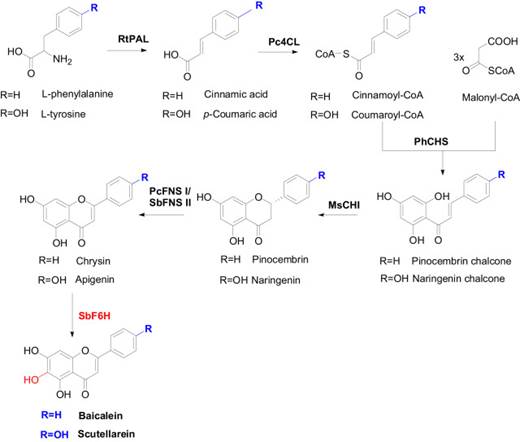黄芩素和野黄芩素的合成生物学研究取得进展
来源:《代谢工程》
作者:JianhuaLi等
时间:2019-01-07


12月3日,国际学术期刊Metabolic Engineering 在线发表了中国科学院分子植物科学卓越创新中心/植物生理生态研究所王勇研究组题为Production of plant-specific flavones baicalein and scutellarein in an engineered E. coli from available phenylalanine and tyrosine 的论文。
黄芩素(Baicalein)是一种黄酮类化合物,是从唇形科多年生草本中药植物黄芩(Scutellariabaicalensis Georgi)的干燥根中提取的主要活性成分,也是中药黄芩发挥药理作用的物质基础之一。近年来,大量的体内外实验均证明,黄芩素具有抗氧化、抗炎症、抗凋亡以及改善学习记忆能力等广泛的生物学活性及药理学活性,其作用谱广、作用位点多、作用机制复杂多样,有望成为安全、价廉且广谱的有效抗肿瘤药物及治疗阿尔茨海默症的潜在理想药物。野黄芩素则主要存在于菊科植物灯盏花(Erigeron karvinskianus)中,具有消炎止痛、活血化瘀和祛风除湿等功效。这两种化合物均有望开发成新型药物造福人类,但其在植物中的天然含量较少,如何高效低成本地获得高纯度化合物是目前研究开发急需解决的问题。利用合成生物学技术实现高效定向合成和规模化制备,是解决上述困难的有效途径。
虽然这两种化合物来源于不同的植物,但其结构具有相似性,其区别在于黄酮母核B环4’位是否有羟基取代。鉴于此,研究者用7个不同物种来源的11个基因构建了一种能定向合成黄芩素或野黄芩素的大肠杆菌,只需提供苯丙氨酸或酪氨酸两种不同的前体,就可以获得这两种重要的黄酮化合物。作者首先将来自欧芹(Petroselinum crispum)的4CL、FNS I,红酵母(Rhodotorulatoruloides)的PAL、矮牵牛(Petunia hybrida)的CHS、苜蓿(Medicago sativa)的CHI等酶的基因构建了黄酮的重要中间体白杨素/芹菜素的合成模块。进一步通过克隆黄芩(Scutellaria baicalensis Georgi)来源的F6H及拟南芥(Arabidopsis thaliana)的AtCPR基因,并引入了不同的助溶标签优化其表达,实现了黄芩素和野黄芩素的异源合成。在此基础上,研究者进一步针对丙二酰辅酶A这一重要前体的供应进行了改造,通过过量表达丙二酰辅酶A合成基因acs和脂肪酸合成基因fabF,并引入三叶草根瘤菌(Rhizobium trifolii)来源的丙二酰辅酶A合酶(malonyl-CoA synthetase)基因matB与丙二酸盐载体蛋白(malonate carrier protein)基因matC,最终在大肠杆菌中实现了摇瓶水平黄芩素23.6 mg/L和野黄芩素106.5 mg/L的产量。该研究为黄芩素和野黄芩素的规模化开发和制造提供了一个不依赖于植物提取的替代方案,也为其他黄酮类化合物的合成生物学制造提供了可借鉴的策略。
该研究工作由王勇研究组的助理研究员李建华及研究生田晨菲、夏裕会等完成。该研究工作得到国家自然科学基金委、中科院分子植物科学卓越创新中心、中科院战略先导B等的资助。(来源:中国科学院植物生理生态研究所)
Production of plant-specific flavones baicalein and scutellarein in an engineered E. coli from available phenylalanine and tyrosine
Abstract Baicalein and scutellarein are bioactive flavones found in the medicinal plant Scutellaria baicalensis Georgi, used in traditional Chinese medicine. Extensive previous work has demonstrated the broad biological activity of these flavonoids, such as antifibrotic, antiviral and anticancer properties. However, their supply from plant material is insufficient to meet demand. Here, to provide an alternative production source and increase production levels of these flavones, we engineered an artificial pathway in an Escherichia coli cell factory for the first time. By first reconstructing the plant flavonoid biosynthetic pathway genes from five different species: phenylalanine ammonia lyase from Rhodotorula toruloides (PAL), 4-coumarate-coenzyme A ligase from Petroselinum crispum (4CL), chalcone synthase from Petunia hybrida(CHS), chalcone isomerase from Medicago sativa (CHI) and an oxidoreductase flavone synthase I from P. crispum (FNSI), production of the intermediates chrysin and apigenin was achieved by feeding phenylalanine and tyrosine as precursors. By comparative analysis of various versions of P450s, a construction expressing 2B1 incorporated with a 22-aa N-terminaltruncated flavone C-6 hydroxylase from S. baicalensis (F6H) and partner P450 reductase from Arabidopsis thaliana (AtCPR) was found most effective for production of both baicalein (8.5?mg/L) and scutellarein (47.1?mg/L) upon supplementation with 0.5?g/L phenylalanine and tyrosine in 48?h of fermentation. Finally, optimization of malonyl-CoA availability further increased the production of baicalein to 23.6?mg/L and scutellarein to 106.5?mg/L in a flask culture. This report presents a significant advancement of flavone synthetic production and provides foundation for production of other flavones in microbial hosts.
原文链接:https://www.sciencedirect.com/science/article/pii/S109671761830332X




